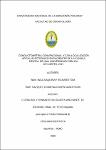| dc.contributor.advisor | Sologuren Anchante, Rafael Fernando | |
| dc.contributor.author | Inga Saquiray, Richard Tom | |
| dc.contributor.author | Vázquez Icomena, Ruben Sanderson | |
| dc.date.accessioned | 2018-08-15T17:53:51Z | |
| dc.date.available | 2018-08-15T17:53:51Z | |
| dc.date.issued | 2018 | |
| dc.identifier.uri | http://repositorio.unapiquitos.edu.pe/handle/20.500.12737/5509 | |
| dc.description.abstract | El propósito del presente estudio fue establecer la diferencia entre la conductometria convencional y con localizador apical electrónico en pacientes de la clínica dental de una universidad pública de Loreto 2017. El tipo de investigación fue cuantitativa, el diseño fue no experimental, descriptivo comparativo, transversal. La muestra estuvo conformada por 23 pacientes que acudieron a la clínica dental de pregrado de la Facultad de Odontología de la UNAP. El instrumento utilizado en el presente estudio fue una ficha de recolección de datos que incluyó la ficha de consentimiento informado.
Los resultados más importantes fueron: El 43,3% de la muestra no presentó diferencias entre ambos métodos de conductometria, el 26,7% presentó una diferencia de 1mm; el 13,3% de 2mm; el 10% de 3mm; el 5% de 4mm y el 1,7% de 6mm. La diferencia de 6mm solo se presentó en el sexo masculino; la diferencia de 4mm fue mayor en el sexo masculino con un 66,7%; la de 1 y 2mm fue mayor en el sexo femenino con el 62,5% y 75% respectivamente; la coincidencia de métodos fue similar 57,7% el masculino y 42,3 el femenino. Las diferencias entre ambos métodos es significativa (p=0,000), lo que demuestra que la conductometria con localizador apical electrónico no puede reemplazar a la conductometria convencional. No existe relación entre la diferencia en la conductometria de ambos métodos y la edad. No existe relación entre la diferencia en la conductometria de ambos métodos y el sexo. La diferencia de 6mm solo se presentó en dientes anteriores; la diferencia de 4mm fue mayor dientes anteriores con un 66,7%; la diferencia de 2mm fue mayor en dientes molares con un 50,0 %; la diferencia de 1mm fue mayor en dientes anteriores con un 50,0 %; la coincidencia de métodos fue mayor en dientes anteriores con un 61,5%. | es_PE |
| dc.description.abstract | The purpose of the present study was to establish the difference between conventional conductometry and electronic apical localizer in patients of the dental clinic of a public university of Loreto 2017. The type of research was quantitative, the design was non-experimental, descriptive, comparative, cross-sectional. The sample consisted of 23 patients who attended the undergraduate dental clinic of the School of Dentistry of the UNAP. The instrument used in the present study was a data collection form that included the informed consent form.
The most important results were: 43.3% of the sample did not present differences between both methods of conductometry, 26.7% presented a difference of 1mm; 13.3% of 2mm; 10% of 3mm; 5% of 4mm and 1.7% of 6mm. The 6mm difference only occurred in the male sex; the difference of 4mm was greater in the male sex with 66.7%; that of 1 and 2mm was higher in the female sex with 62.5% and 75% respectively; the coincidence of methods was similar 57.7% male and 42.3 female. The differences between both methods is significant (p = 0.000), which shows that conductometry with electronic apical localizer can not replace conventional conductometry. There is no relationship between the difference in the conductometry of both methods and age. There is no relationship between the difference in the conductometry of both methods and sex. The difference of 6mm only occurred in anterior teeth; the difference of 4mm was greater anterior teeth with 66.7%; the difference of 2mm was greater in molar teeth with 50.0%; the difference of 1mm was greater in anterior teeth with 50.0%; the coincidence of methods was higher in anterior teeth with 61.5% | en_US |
| dc.description.uri | Tesis | es_PE |
| dc.format | application/pdf | es_PE |
| dc.language.iso | spa | es_PE |
| dc.publisher | Universidad de la Amazonía Peruana | es_PE |
| dc.rights | info:eu-repo/semantics/openAccess | es_PE |
| dc.rights | Attribution-NonCommercial-NoDerivs 3.0 United States | * |
| dc.rights.uri | http://creativecommons.org/licenses/by-nc-nd/3.0/us/ | * |
| dc.source | Universidad Nacional de la Amazonía Peruana | es_PE |
| dc.source | Repositorio institucional - UNAP | es_PE |
| dc.subject | Conductometría | es_PE |
| dc.subject | Radiografía dental | es_PE |
| dc.subject | Clínicas odontológicas | es_PE |
| dc.subject | Universidades estatales | es_PE |
| dc.title | Conductometría convencional y con localizador apical electrónico en pacientes de la clínica dental de una universidad pública de Loreto, 2017 | es_PE |
| dc.type | info:eu-repo/semantics/bachelorThesis | es_PE |
| thesis.degree.discipline | Odontología | es_PE |
| thesis.degree.grantor | Universidad Nacional de la Amazonía Peruana. Facultad de Odontología | es_PE |
| thesis.degree.level | Título Profesional | es_PE |
| thesis.degree.name | Cirujano Dentista | es_PE |
| thesis.degree.program | Regular | es_PE |
| dc.subject.ocde | http://purl.org/pe-repo/ocde/ford#3.02.14 | es_PE |


